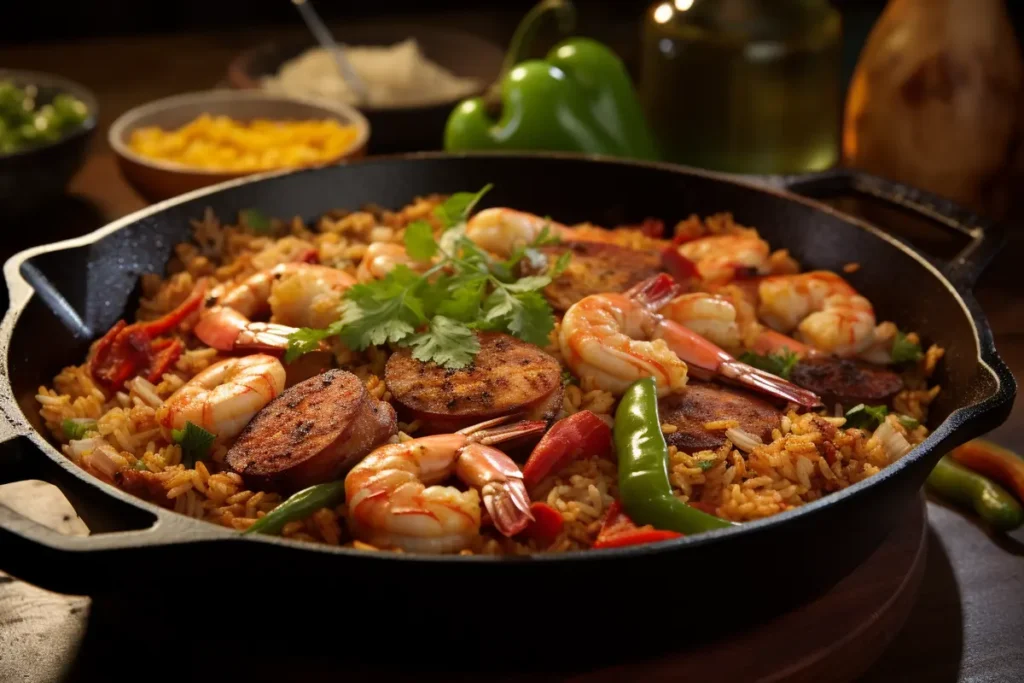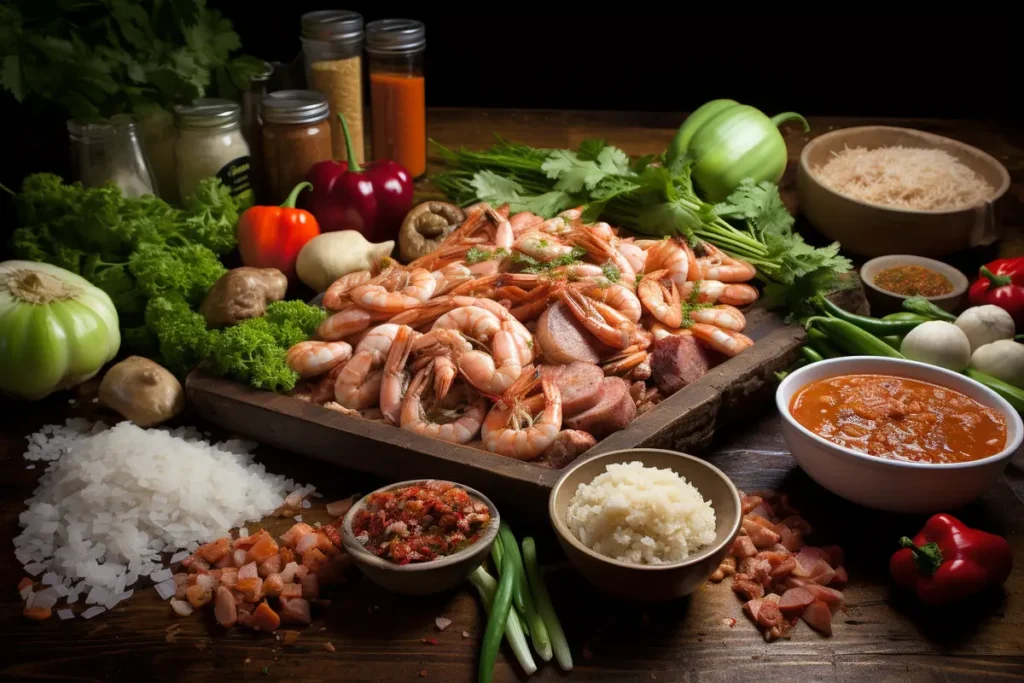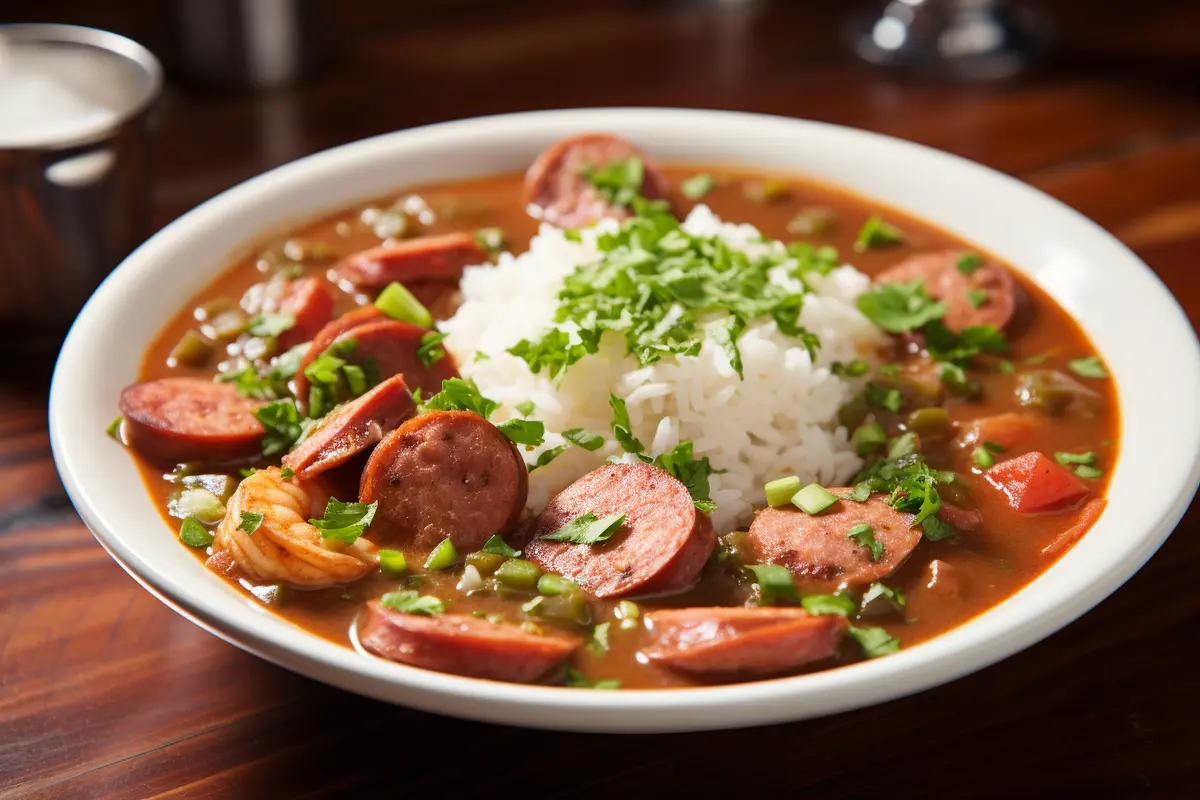The smell of gumbo reminds me of my grandmother’s kitchen in New Orleans. As a kid, I’d watch her make the dark roux. She’d add colorful veggies and juicy meats. That smell meant love, family, and fun times were coming.
Now, I’m excited to share this special gumbo recipe with you. It brings a bit of Cajun cuisine to your home.
This gumbo recipe has 211 glowing ratings. It captures the heart of New Orleans cooking. It uses the “holy trinity” of onions, bell peppers, and celery with a perfect roux. The result is a hearty, flavorful dish perfect for family dinners or parties.
Your gumbo adventure starts with chicken, andouille sausage, and optional shrimp. These ingredients mix with spices in a rich tomato broth. Whether you’re new to Cajun cuisine or a pro, this recipe offers authentic flavors for your table.
Ready to explore gumbo? Let’s look at its rich heritage, key ingredients, and how to make it. Get ready to wow your loved ones with a taste of New Orleans!
Understanding the Rich Heritage of Cajun and Creole Gumbo
Gumbo is a key dish in New Orleans, with a history that goes back centuries. It started in Louisiana in the 18th century. It mixed flavors from different cultures.
Origins of Louisiana Gumbo
The name “gumbo” comes from “kingombo,” a Bantu word for okra. Okra, along with file powder from Choctaw Indians and French roux, are key to this dish.

Difference Between Cajun and Creole Styles
Cajun gumbo comes from rural Acadiana. It has a darker roux and stronger flavors. It often has chicken or pork sausage. Creole gumbo, from New Orleans, has tomatoes and seafood. This makes it lighter and tangier.
Cultural Significance in New Orleans Cooking
Gumbo is very important in Louisiana’s food scene. It’s a favorite at Mardi Gras. There are many ways to make it, showing the area’s cultural mix.
Every gumbo must include the “holy trinity” of vegetables: onion, celery, and green bell pepper.
Gumbo is a symbol of Louisiana’s rich food culture. It’s loved for its complex tastes and varied ingredients. It’s a favorite around the world.
Essential Ingredients for Authentic Gumbo Recipe
Starting a delicious gumbo recipe means picking the right ingredients. Your gumbo will be amazing with fresh veggies, savory meats, and spices. Let’s look at the main parts that make gumbo so loved.
The Holy Trinity: Onions, Celery, and Bell Peppers
The heart of any gumbo is the Cajun Holy Trinity. This mix of onions, celery, and bell peppers is key. Chop them finely and sauté to bring out their flavors. This Trinity adds depth and richness, making your gumbo authentic.

Protein Options: Chicken, Sausage, and Seafood
Gumbo is great because you can use different proteins. Chicken gumbo is a favorite, with tender meat that absorbs all the flavors. Andouille sausage adds a smoky, spicy taste. For seafood fans, shrimp gumbo is a must-try. Mix and match these proteins to make your ideal gumbo. You can use up to 1 pound of three different meats or seafood.
Selecting the Right Seasonings and Spices
The secret to a tasty gumbo is its seasoning. Start with a Cajun spice blend. Add about 2 teaspoons for a nice kick. Don’t forget bay leaves, thyme, and garlic for more depth. Balance these flavors to make a gumbo that’s full of taste but not too strong.
- Use fresh herbs when possible for the best flavor
- Adjust spice levels to your liking
- Remember, you can always add more seasoning, but you can’t take it away
With these key ingredients, you’re set to start your gumbo adventure. The secret to a great gumbo is balance and patience. Happy cooking!
Mastering the Perfect Roux
The key to a great gumbo is a perfect roux. It needs patience and precision. Let’s explore how to make a flawless roux for your gumbo.
Choosing the Right Oil and Flour Ratio
For a classic gumbo, mix equal parts vegetable oil and all-purpose flour. Start with ½ cup of each for a basic recipe. If you want a thicker gumbo, add more flour to ¾ cup while keeping oil at ½ cup.
Achieving the Ideal Color and Consistency
Cook your roux over low heat for 20 to 30 minutes, stirring constantly. It should darken to a rich, chocolate brown. This step is key for deep flavors in your gumbo.
Common Roux-Making Mistakes to Avoid
Avoid these mistakes when making your roux:
- Rushing the process – patience is key
- Using high heat, which can burn the roux
- Not stirring consistently, leading to uneven cooking
- Undercooking, resulting in a pale, flavorless base
Remember, a well-made roux is the secret to a mouthwatering gumbo. With practice, you’ll master this technique and impress everyone with your delicious stews.
Step-by-Step Gumbo Recipe
Ready to dive into the world of cajun cuisine? This gumbo recipe brings the flavors of New Orleans right to your kitchen. Get your ingredients ready and let’s start cooking this classic creole dish!
Start by heating 1/2 cup of vegetable oil in a Dutch oven over medium-high heat. Once it’s nearly smoking, it’s time to create your roux. Gradually whisk in 2.5 cups of all-purpose flour, stirring constantly for about 15 minutes until it reaches a deep chocolate color.
Next, add your “holy trinity” of vegetables:
- 1 diced onion
- 3 chopped bell peppers
- 1 bunch of sliced celery
Sauté these for 10 minutes, then toss in minced garlic and cook for another 5 minutes. Now it’s time for the protein. Add 2 pounds of sliced andouille sausage and cook until browned.
Pour in 4 cups of chicken broth and bring to a simmer. Season with:
- 1 teaspoon each of celery salt, gumbo filé, and cayenne pepper
- 2 bay leaves
- Creole seasoning to taste
Let your gumbo simmer for 30 minutes. In the last 15 minutes, add 2 pounds of shrimp. Cook until the shrimp turn pink. Serve your gumbo over a cup of star-shaped rice for an authentic touch.
“A good gumbo is a gift that keeps on giving. It’s even better the next day!”
This gumbo recipe serves 8 and takes about 3 hours to prepare and cook. It’s perfect for those chilly Texas evenings when you crave a comforting bowl of cajun goodness.
The Art of Seasoning Your Gumbo
Seasoning is crucial for a tasty gumbo. The right mix of spices can make your dish unforgettable. Let’s dive into the secrets of seasoning your gumbo perfectly.
Traditional Creole Spice Blend
A classic creole spice mix includes paprika, garlic powder, onion powder, oregano, and thyme. For a real gumbo, use 1 tablespoon of Cajun seasoning. This blend brings depth and complexity to your dish.
Heat Level Adjustments
You can adjust the heat of your gumbo to your liking. Start with 2 teaspoons of hot sauce. You can add more at the table. The goal is to enhance, not overwhelm, the flavors.
Using Fresh vs. Dried Herbs
Fresh herbs add a burst of flavor to your dish. Use 1 tablespoon of chopped fresh thyme in your gumbo. If using dried herbs, use half the amount. Fresh herbs should be added towards the end to keep their flavor.
“Seasoning is the soul of gumbo. It’s what turns a simple stew into a memorable cajun experience.”
Remember to season with 1 tablespoon plus ½ teaspoon of kosher salt and ½ teaspoon of black pepper. Taste and adjust as you go. This ensures your gumbo is perfectly balanced and full of authentic cajun flavors.
Protein Variations and Combinations
Gumbo is a dish that lets you get creative with proteins. You can make a classic chicken gumbo, a flavorful shrimp gumbo, or a hearty seafood gumbo. The fun part is mixing and matching proteins to match your taste.
For a traditional taste, mix chicken and andouille sausage. This combo offers tender chicken and smoky sausage. Use 2 pounds of chicken thighs and 12 ounces of sliced sausage for a great mix.
If you love seafood, try shrimp and crab together. Use 1 pound of peeled shrimp and 8 ounces of crab meat. This gumbo will have a light flavor and different textures.
- Chicken Gumbo: Use 2 pounds of boneless, skinless chicken thighs
- Shrimp Gumbo: Add 1 pound of large shrimp
- Seafood Gumbo: Combine shrimp, crab, and oysters
- Mixed Gumbo: Blend chicken, andouille sausage, and shrimp
Remember to adjust cooking times based on your protein choices. Chicken takes 2-3 minutes per side to brown. Shrimp cooks fast, in just a few minutes. Always make sure your proteins are fully cooked before serving.
“Gumbo is like a big pot of love. You can put whatever you want in it, and it always turns out delicious!” – Chef John Besh
Try different combinations to find your favorite gumbo recipe. Whether you like a classic chicken gumbo or a rich seafood gumbo, the possibilities are endless in the kitchen.
The Role of Okra and Filé Powder
Okra and filé powder are key to thickening and flavoring gumbo. They give okra gumbo its unique texture and taste. Let’s look at how to use them well in your gumbo recipe.
Natural Thickening Methods
Okra is a main thickener in classic Louisiana gumbos. Its sliminess, often seen as a problem elsewhere, is great for gumbo’s texture. A cup of sliced okra is usually enough to thicken a pot of gumbo.
Filé powder, made from ground sassafras leaves, is another traditional thickener. It brings a unique earthy flavor to your gumbo. Use about 2 teaspoons of filé powder per pot to avoid sliminess.
When and How to Add Thickeners
Add okra to your gumbo during cooking. It needs time to thicken. For a 4-serving gumbo, add 1 cup of sliced okra about 30 minutes before it’s done.
Filé powder is different. Add it at the table or after removing the gumbo from heat. Don’t add filé while the gumbo is still cooking or when reheating, as this can make it stringy.
“Gumbo” comes from an African word for okra, highlighting its importance in this dish.
The thickness of your gumbo can vary based on your chosen method. Experiment with these thickeners to find your perfect gumbo consistency.
Serving and Presentation Tips
Your gumbo recipe is ready, and it’s time to serve this New Orleans cooking classic. Presentation is key to a great dining experience. Here are some tips to make your gumbo shine.
Rice Pairing Suggestions
Gumbo is traditionally served over rice. Use 300g (1.5 cups cooked) of white rice per serving. This balance is perfect. For a healthier option, try brown rice or quinoa.
Traditional Garnishes
Enhance your gumbo’s flavor and appearance with traditional garnishes. Sprinkle fresh chopped parsley on top for a pop of color. Add a dash of filé powder for extra thickness and flavor.
Green onion tops provide a mild, fresh taste. These garnishes not only look great but also add depth to your gumbo recipe.
Serve your gumbo in large, shallow bowls. This allows the rice to sit in the center with the gumbo surrounding it. The wide bowl also showcases the variety of ingredients in your New Orleans cooking masterpiece.
For special occasions, consider using decorative bowls to elevate the presentation.
Remember, gumbo serves about 10 people per recipe. It’s perfect for family gatherings or celebrations like Mardi Gras. The adaptability of gumbo allows you to cater to various dietary needs.
Whether you’re serving a crowd or enjoying a cozy dinner, these serving tips will make your gumbo a standout dish.
Storage and Reheating Guidelines
Your gumbo recipe makes about 6 servings, great for eating over a few days. Store leftovers in an airtight container in the fridge for up to 4 days. For longer storage, freeze your gumbo in a freezer-safe container for up to 3 months.
When you’re ready to enjoy your leftover gumbo, thaw frozen portions overnight in the refrigerator. Reheat on the stovetop or in the microwave until piping hot. If the gumbo thickens too much, add a splash of water or broth to reach your desired consistency.
Remember, reheating won’t compromise the flavors of your gumbo. The “holy trinity” of onion, bell pepper, and celery forms a robust base that stands up well to storage and reheating. Many gumbo lovers find the flavors even more developed after a day or two!
“I’ve been making this gumbo recipe for over 10 years. It’s always requested for holidays and gatherings,” shares one community member.
Keep in mind the nutritional content per serving: 435 calories, 26g protein, and 31g fat. Enjoy your reheated gumbo with a fresh side of rice for a comforting meal any day of the week.
Troubleshooting Common Gumbo Issues
Making a perfect gumbo recipe can be tricky. Here are some tips to fix common problems with your roux-based stew.
Fixing a Broken Roux
If your roux separates or burns, start over. Use a 1:1 ratio of fat to flour by weight. Cook slowly for 2-4 hours in the oven for a dark roux. Stop at milk chocolate color to avoid bitterness. If it’s undercooked, your gumbo may taste floury and lack thickness.
Adjusting Thickness
For a thin gumbo, add okra or filé powder. Okra’s natural mucilage helps thicken the stew. Add it 30 minutes before serving. If too thick, thin with chicken stock. The recipe suggests 6-8 cups, so adjust as needed.
Balancing Flavors
To balance flavors, use the “holy trinity” of onions, bell peppers, and celery. Fresh ingredients boost flavor more than canned. Add shrimp and crab in the last few minutes to prevent rubbery texture. For richer taste, let gumbo sit for 24 hours before serving.
“A truly great gumbo takes 6-8 hours from prep to serving. Patience is key for flavor development.”
Remember, gumbo-making is an art. With practice, you’ll master this delicious roux-based stew.
Conclusion
Learning to make gumbo is a journey into Cajun cuisine and New Orleans cooking. This dish is a mix of comfort and excitement. It starts with a roux, simmered for about 20 minutes to get that deep flavor.
A great gumbo needs time and patience. It takes 30 minutes to prepare and 2 hours to cook. It serves 8 people well, with each serving having 505 kcal. It has 34g of protein and 36g of carbs.
The mix of seafood and sausage adds to the dish’s texture and taste. The holy trinity of vegetables is its backbone. As you simmer it for an hour, you’re not just cooking. You’re joining a culinary tradition.
Whether you thicken it with okra or filé powder, your gumbo will share a story of cultural fusion. So, grab your pot and ingredients. Start your gumbo-making journey. With each batch, you’ll get better and appreciate this Cajun cuisine staple more.

